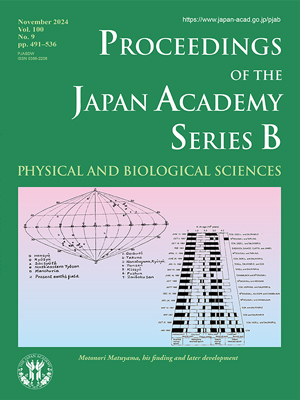About the Cover
Vol. 100 No. 9 (2024)
The two cover figures are cited in M. Kono (this issue, pp. 491–499) who reviewed the paper “On the direction of magnetization of basalt in Japan, Tyôsen and Manchuria” by Motonori Matuyama. This well-known paper was published in the Proceedings of the Imperial Academy of Japan almost a century ago. It was already known at that time that volcanic lava was magnetized during cooling toward the Earth’s magnetic field. Matuyama collected 139 basalts specimens from 36 places in Honsyû, Kyûsyû, Korea, and Northeastern China, where the present-day magnetic direction varies from 4.5° to 6.5° to the west in declination and from 40.5° to 60.0° downward in inclination. The magnetic directions he recovered from his collection were scattered either around this range or around almost exact antipodal directions. The left-hand figure (Matuyama, 1929) illustrates this situation, where the inclination and declination of the magnetic direction are plotted at the corresponding latitude and longitude on the world map. If the inclination was downward or upward, the plot was made on the south or north hemisphere. In this way of plotting, the Quaternary (2.58 Ma–Present) basalt rocks from Yakuno (35.2°N, 135.0°E) were positioned in the southern hemisphere, whereas those from Genbudô (35.6°N, 134.8°E) were located in the northern hemisphere despite their close proximity to locality. Similarly, Quaternary basalt rocks from Tansen (Tancheon River?) in Korea are plotted in the southern hemisphere, whereas those from Kissyû (Kiju?) in Korea are plotted in the northern hemisphere. Based on these observations, Matuyama concluded that the Earth’s magnetic field was in an almost exactly antipodal state in the earlier part of the Quaternary period, which then changed to the present-day normal state. He further suggested, based on an analysis of basalts from older ages, that similar reversal events have occurred in older geologic pasts.
Matuyama correctly assigned the most recent geomagnetic reversal in the early Quaternary. According to Kono (this issue), Matuyama’s paper did not receive much attention at the time of publication and was soon forgotten, but there was a dramatic revival in the 1960s. Kono described this revival drama and re-evaluated its significance through a longer history of paleomagnetic studies. The revival was synchronous with the development of K–Ar dating, a dating method based on the decay of radioactive elements, and the consequent development of the time table of geomagnetic reversal. The right figure (Dalrymple, 1972) illustrates how fast these developments were and how hot competition was among a few groups. The timetables from these groups reached a reasonable agreement around 1966, which is sufficiently accurate to define geologic age boundaries. The established timetable has been used in a variety of fields, including the dating of ocean sediments and the seafloor itself. Matuyama’s contribution to the development of paleomagnetic studies is now appreciated by the name of “Matuyama epoch” given to the most recent reversal event.
Yoshio Fukao
Member of the Japan Academy




